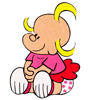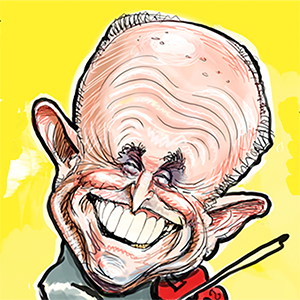5 things we learned from Orioles' 2-1 loss to the Royals in Game 2 of AL wild-card series
Published in Baseball
BALTIMORE — The Orioles’ season ended meekly with their bats failing for a second straight night in a 2-1 wild-card loss to the Kansas City Royals.
Here are five things we learned from Wednesday’s game at Camden Yards:
For all their talk of professional calm, the Orioles’ bats again went silent when it counted
They swore no one felt daunted. What else could they say after four straight playoff losses over two seasons, after they wasted a gem from Corbin Burnes in Game 1? Outward resolve was the only option.
“I think you have to do your best to not think about it,” outfielder Colton Cowser said before Game 2. “I think having a short memory — it’s a pretty cliche answer, but having a short memory in this game is extremely important.”
He grinned and joked as if he was about to play a random Wednesday game in July, not as if the Orioles’ season might be over in a few hours.
But those were words. When it was time for action a few hours later, the Orioles fell back into the same disturbing pattern that haunted them through much of September and into October. They pitched and defended well enough to send the Royals packing. And they scored all of one run in two games — remarkable futility from an offense that led the American League in slugging.
Their best player, Gunnar Henderson, swung through a changeup to put the final stake in this epic spectacle of self-defeat. It was a fitting image given how the team’s sluggers flailed against the Royals.
Their nadir came in the bottom of the fifth. The Orioles bases loaded the bases with no outs after Cedric Mullins tied the game at 1. Anthony Santander, No. 2 in the AL in home runs, popped out. Cowser, likely to finish second in AL Rookie of the Year voting, struck out on a pitch that hit him and fractured his left hand. Adley Rutschman, whose brutal second half carried into the playoffs, grounded out.
In the next half-inning, the Royals scratched a run out of two infield hits and a bloop single. They couldn’t muster much offense either, but one little burst was enough to outdo the lineup that never pulled out of its late-season swoon.
Even when the Orioles struck the ball hard, the fates were not with them.
In the bottom of the third, Kansas City left fielder MJ Melendez chased down a Rámon Urías drive (98.9 mph off the bat) at the wall. Henderson was up next, and he sent a screamer down the right field line, foul of course.
In the next inning, with runners on first and second, Ryan O’Hearn looped a ball up the middle that would have put the Orioles on the board, but Royals second basemen Michael Massey extended to snare it. Ryan Mountcastle then flied out softly to end the threat.
“I feel terrible,” O’Hearn said, reflecting on two days of empty offense. “Terrible for our fans, and [I] feel like we let them down. It just sucks. Seems like, obviously we didn’t score runs and we didn’t get any big hits when we needed to, and [I] just feel terrible about it.”
The Orioles have set themselves up for some harsh self-examination between now and February when they begin again in Sarasota, Fla. Everything from their coaching methods to their reliance on free-swinging power bats will be on the table. They’re overflowing with talented young hitters who will improve naturally. They also need to think hard about adding at least one proven hitter who excels at getting on base, something general manager Mike Elias did not do at the trade deadline.
“It’s obviously something we need to take care of,” Henderson said. “But we’ve also done really well hitting with runners in scoring position. I don’t know what to tell you. We went up there and tried to battle. It just didn’t work out.”
The Orioles’ offense was broken in the biggest games of the season. There’s really no other way to put it.
Starting pitching did not do them in this time
The talk coming out of last year’s dispiriting sweep at the hands of the Texas Rangers was how the Orioles needed to overhaul their starting rotation. Elias’ biggest move of the offseason and his biggest at the trade deadline targeted this issue, and the club really did pitch better this time around, even missing some of the powerful arms that were lost to injury along the way.
Game 2 starter Zach Eflin was a touch unlucky in the first inning. Massey sent a 2-2 changeup scooting just fair down the right-field line for a double. Then, designated hitter Vinnie Pasquantino poked a single through the right side of the infield to put Kansas City up 1-0. Eflin had done his thing, getting ahead in the count and avoiding anything dumb, but still he trailed.
He settled in, pitching out of trouble in the third and generally delivering the calm manager Brandon Hyde had forecast before the game. “He doesn’t get too excited, doesn’t get too low,” Hyde said. “He’s just really, really relaxed in the clubhouse and on the field, so we’re looking forward to watching him pitch.”
Eflin made it through four innings on 75 pitches before Hyde turned to Danny Coulombe in the fifth. Aggressive managing makes sense when there’s no tomorrow, and he was likely reacting to data that shows Eflin is much worse the third time through an order. Nonetheless, his hook felt strangely quick. Coulombe and Jacob Webb made a mess, loading the bases and barely escaping on Webb’s strikeout of Melendez.
With Eflin’s departure, the pitching line for Orioles starters stood at 12 innings, two runs and nine hits allowed through two games — plenty good enough to win most series, just not this one.
Brandon Hyde is in for a long offseason of criticism, but it’s not time for his Baltimore story to end
Anger at Hyde crescendoed after Game 1 when fans wondered why he did not order Burnes to walk Bobby Witt Jr. with the go-ahead run on third in the sixth inning and why he started James McCann, who was helpless in two at-bats against Cole Ragans.
A rational respondent might have answered that the Orioles lost because their top four hitters reached base twice in 16 plate appearances, not because of their manager’s tactics. Burnes had handled Witt with his cutter in two previous at-bats, and the Orioles would have opened the possibility for a bigger inning by putting the speedy shortstop on first. As for McCann, he’s the catcher Burnes seems most comfortable with, and getting a great start was priority No. 1 going into the game. Might the Orioles have scratched out a run in the fifth if Emmanuel Rivera, instead of McCann, came up with two men on in the fifth? It’s a fair question, but Hyde had his reasons for going with the veteran catcher.
The greater point is that these choices empowered Hyde’s critics, who’ve spent much of the season arguing he’s not the manager to take the Orioles to the promised land. Likable guy, steady hand when the team was losing 110 games and a winning future was a speck on the horizon, but not the game manager needed for the October crucible. That’s the line on Hyde from those who’d like to see a different person filling out the lineup and deploying the bullpen in 2025.
Let’s be clear. We’re unlikely to see a change, even though Hyde and Elias will be asked about his future during their postseason news conferences. You don’t casually dump a manager who took the club from 52 wins to 83 to 101, then guided the Orioles to a second straight playoff appearance for the first time since 1997.
It’s easy to speculate that he lost the clubhouse when the Orioles spiraled in August and September, but if we actually listen to the players, they’re not saying that or even hinting at it.
“I think he said all the right things,” O’Hearn said when asked how Hyde navigated those difficult stretches. “He came in and talked to us and had words of wisdom whenever things seemed bleak in the clubhouse and we were going through a losing stretch. … I don’t know if there is like one specific thing. I think it was more of like a, hey, let’s be honest with ourselves with how we’re playing and where we’re at.”
On the tactical side, Hyde isn’t Earl Weaver, crafting the entire vision for how his club will operate on the field. He’s doing it in collaboration with Elias, Sig Mejdal and all the data explorers who feed their vision for winning. That was the plan from Day 1. Six years later, there’s no sign the brain trust is cracking.
Not that we should dismiss all criticisms. At times, Hyde does reach for his bullpen too quickly or defy common sense in seeking a platoon advantage. If the Orioles keep banging their heads against the same ceiling, they’ll have to consider change for change’s sake.
This series against the Royals was not the data point to tell us that time is now.
Don’t tell Cedric Mullins the Orioles can’t hit in the postseason
The crowd at Camden Yards finally got to roar in earnest when Mullins drilled Seth Lugo’s fastball 398 feet into the right field stands to make it 1-1 in the bottom of the fifth.
The Orioles center fielder had narrowly missed sending one over the scoreboard the day before. He was the only man making noise on a day when Baltimore bats fell silent.
Mullins has played that role for months. After he hit .136 in May, he quietly revived his season, slugging .520 in June and .488 in September, a time when the lineup around him floundered. Before Game 2, his was one of two names Hyde mentioned when asked who would lead the Orioles through a do-or-die day.
Mullins is one of the few Orioles who were around before the club began its rise from the ashes. He’s seen the most hopeless misery baseball has to offer, performed at a near-Most Valuable Player level on a team that lost 110 games. He struggled terribly last October, going hitless in 12 playoff at-bats. That too, shaped him.
“I think it’s made a big difference in terms of approach and mindset,” he said Wednesday. “Just knowing and understanding the game is the exact same. We’ve got to go do the same stuff we’ve done for 162 games, and in my mind, this is 164.”
Mullins earned his venerated elder status and the love that descended upon him when he clocked that pitch into the seats Wednesday.
An offseason of hard questions begins now
This season turned strange in July. For years, the Orioles had risen on a near-vertical incline, improving from 52 wins to 83 to 101 and on pace for 107 as of June 20. Every few months, they seemed to greet another prospect deemed one of the best (sometimes the very best) in baseball. They were a machine of progress, on the field and on the farm.
Then, out of nowhere, they started losing as often as they won. Injuries wrecked their projected playoff rotation. Their bullpen bets went south. Their phenoms suffered severe growing pains. Their mighty lineup punched below its weight on way too many nights. Their future still seems bright but no longer limitless.
“It’s definitely not ending,” Hyde said. “I think especially when you lose like this, there’s frustration, there’s anger, there’s disappointment because you felt like there was opportunities there in those couple games to change the score, and it didn’t happen.”
And that’s where we stand after another quick, uninspired playoff exit, one that sets up an offseason of heavy questions.
Burnes gave the Orioles one terrific season and an even better playoff start. Will new owner David Rubenstein even try to re-sign their ace at a likely cost of $250 million or more?
What about Santander, a ground-floor architect of the club’s renaissance who saved the day again and again with his slugging this summer? Will he be too expensive in free agency?
Will an inevitable rethinking of the bullpen work out better than it did in 2024? A returning Félix Bautista will help but not necessarily right away given that he’ll pitch with a reconstructed elbow.
Eflin, Grayson Rodriguez and eventually Kyle Bradish project as a nice top to the rotation, but if the Orioles don’t make an aggressive play for Burnes, will they add another significant outside arm?
Will Jackson Holliday, Coby Mayo and Heston Kjerstad take steps forward, as Cowser did this year, to help the Orioles transition from one version of their lineup to the next?
Will Rutschman, long thought to be the cornerstone of the club’s progress, put a confounding season behind him? We expected a Most Valuable Player candidate. In the second half, Rutschman didn’t even hit at replacement level.
The Orioles could have taken the edge off some of these questions by winning a few playoff series. Instead, their long months of reckoning have arrived.
____
©2024 Baltimore Sun. Visit baltimoresun.com. Distributed by Tribune Content Agency, LLC.







Comments